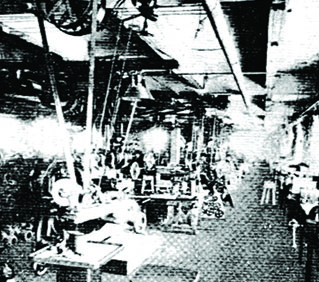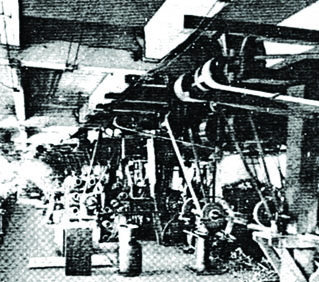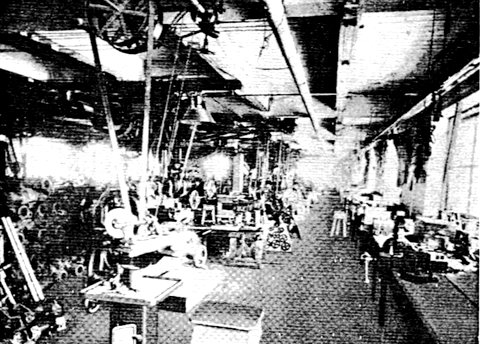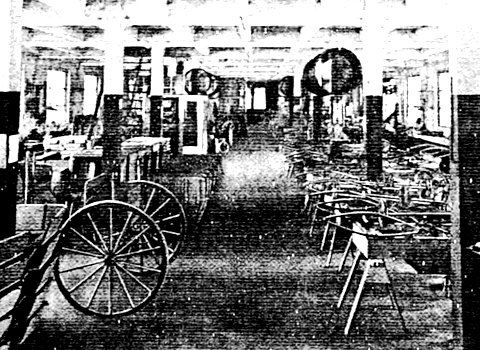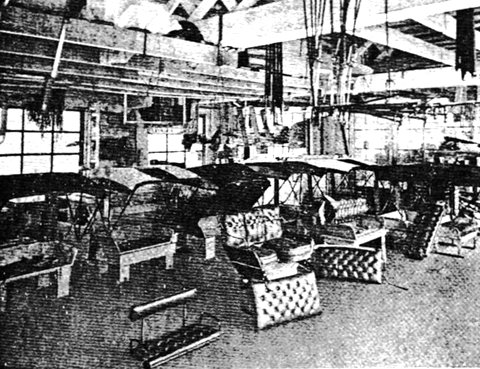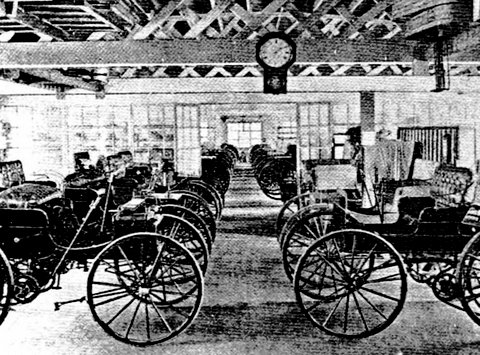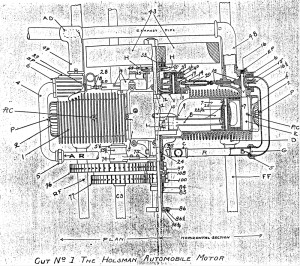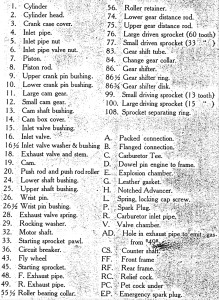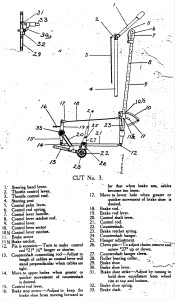Vehicle & Motor Numbers
The vehicle number for those numbered 1800 through 2999 appears on the brass name plates with the digit number followed with the suffix “V”. On the earlier Holsmans the number did not appear on the nameplate, but was stamped on various parts of the body. Vis: Inside the front storage box, under the rear front floor board, on the seat frame or underneath the rear body cross frame. On those Holsmans with vehicle numbers 3000 and up, the “V” suffix was not normally stamped on the nameplate.
Since H. K. Holsman, as well as many other automobile manufacturers during this period, referred to their vehicle engines as “motors”, we will also refer to them as motors. The Holsman motor numbers were stamped on the periphery of the flywheels. The second and third series motors added the suffix “M” to the digit number. There are some exceptions where the “M” suffix was omitted for an unknown reason. These numbers appear to be the only true serial numbers that Holsman used, as will be seen later.
No known recorded of any Holsman vehicle or motor numbers exists nor have any original bills of sale yet been located which would tie down a serial number of any sort to the year of sale or manufacture. However, Holsman vehicle number 1893, with motor number 883, has a 2″ metal disc mounted on the front with the following inscription: REGISTERED in the office of the SECRETARY of STATE for the State of SOUTH DAKOTA under motor vehicle law – 738. Mr. J. B. Howell of St. James, Missouri, in 1978, at the age of 91, sold this car to Memoryville U.S.A., a museum in Rolla, Missouri. He advised that he had purchased it from a Doctor in South Dakota, whom he believed to have been the original owner. Checking with the South Dakota State Historical Society, Pierre, S.D., we found that this car was originally registered by a J.R. Wallace of Pine Ridge, South Dakota on 13 June 1907, and later transferred to A. C. Lindbo of Wallace, S.D. on 21May 1910. It would then appear that Mr. Wallace was the original first owner.
Assuming one to two months from the time of manufacture until it was shipped, received, assembled, and registered, it may then be assumed that vehicle, number 1893, was manufactured in early April 1907 as the 94th vehicle in lot 18.
There is a large gap in the known vehicle numbers, 657 to 1893. From the existing facts we can arbitrarily assume that they began a new series of numbers at 1800 as they had planned to begin using the THIRD variety motor, but first used up the balance of the SECOND variety. We can therefore assign the 1907 Vehicle numbers using the balance of the SECOND variety of motors as being in the 800- to 1100- ranges. Then, the balance of vehicles manufactured in 1907 using the THIRD variety motor, is (746-206) = 542, which gives us Vehicle numbers in the 1800- through the 2200- ranges. (We obtained 206 from a formula shown later on) Thus, the overall vehicle numbers for 1907 appear to have begun with 818 and ended in the 2200- range.
Below are the approximate vehicle numbers listed according to their years of manufacture, plus a listing of the estimated number manufactured in the respective years. Even though they were working on their four cylinder motors in early 1908, they did not advertise these “H” & “K” type motors until 1910 when they first appeared in that years catalogs. However, they were being manufactured, installed, and sold in their cars by at least mid-1909.
In the following chart, each vehicle number range may or may not have been completely assigned to Holsman vehicles. Thus, if only 69 vehicles were manufactured in lot number 21, the highest number would have been 2168, and the next vehicle manufactured would be assigned number 2200, indicating that it was the first vehicle in the next lot number, 22. Holsman, vehicle #310, has the date 3/13/05 also stamped on the flywheel. This indicates that they probably began with #300 it 1905. DO NOT consider these figures to be exact. They do represent the best possible estimate based on the known facts and qualified estimates.
| Vehicle No. Ranges |
Year |
No. Mfg. |
Orders Received |
| 100- |
1903 |
13 |
17 |
| 200- |
1904 |
50 |
43 |
| 300- 400- |
1905 |
129 |
120 |
| 500- 700- |
1906 |
389 |
526 |
| 800- 1000- |
1907 (206)† |
|
|
| 1800- 2200- |
1907 (542)** |
748 |
763 |
| 2300- 2700- |
1908** |
451 |
398 |
| 2800- 2900- |
1909 (200)** |
|
|
| 3000- 3399- |
1909 (459)§ |
659 |
428 |
| 3400- |
1910§ |
20* |
20* |
|
Approximate total mfg. |
2439
|
|
| Approximate number of orders received |
|
2315
|
(*) Approximate
(†) SECOND variety motors.
(**) THIRD variety motors.
(§) Fourth & Fifth, types “H” & “K” motors.
Note also that some of the manufacturing figures listed above vary from others listed elsewhere in this history. Determining these figures is only an estimate, thus the difference occurs from using two different methods to arrive at these results, plus the fact that the HACo’s summation reports varied from year to year.
One method of determining the approximate number of motors used, thus the number of vehicles manufactured, is by calculation using the known existing motor numbers. Take the highest found numbers from each type of motor, 1 through 3, [1893], and of types 4 and 5 (“H” & “K”), [3333], remembering that types 4 and 5 began with serial number 3000, and place them in the following equation: (1893 – 100 + 1) + (3333 – 3000 + 1) = 2128, the number of motors used.
The Henry Ford Museum has an early Model 3 for which they list a number 10 on the motor. This number also appears on another early Holsman motor, and it proves to be a part number rather than a motor number. The number 0010 is stamped on one cylinder and the number 0011 on the other, plus the letters HOL. This might indicate that the castings were made outside of the Holsman factory. We are assuming that Holsman began his motor numbering system with #100. This assumption is based on the fact that many early automobile manufactures started their numbering system with a number higher than 1. This was purportedly to give the impression that they had been in business for a time. Undoubtedly, there were some numbers above 3333, so let us assume that this number is under by approximately 10%. Then the total number of motors manufactured and installed in their cars would have been (2128 x 1.1) = 2341, which is an approximation of the total number of vehicles manufactured during the active lifetime of the Holsman Automobile Company, and close to the calculated 2439.
As of this writing, there are known to exist Holsmans and Holsman motors only, with the motor numbers in the number ranges 100 through 600, 800 through 1800, and 3100 through 3300. It is assumed that there are motors with serials in some of these missing hundred ranges not yet located.
Actually, Holsman vehicle numbers are not true serial numbers at all, but represent a type of numbering code used by Holsman. Quoting directly from their NAME PLATE Blueprint #6L12: Vehicle No.’s to start with 00 and run to 99 for each lot, prefixed by the lot no. FOR EXAMPLE – 2600 to 2699 the first two figures indicating the lot, the last two figures indicating the serial number of said lot. This means that the serial number of the vehicle within each lot is 1 less than the actual number of vehicles manufactured within the lot i.e.: Number 600 would be lot 6 vehicle number 1; number 2453 would be lot 24 vehicle number 54; number 1499 would be lot 14 vehicle number 100, etc.
Thus far, no information has as yet been located which would indicate that each lot number was completely filled with the allowable 100 vehicles. To the contrary, the number of extant vehicles together with their numbers leads one to believe that the lots were not completely filled with 100 vehicles each.
Another factor to bear in mind when trying to determine the year of a Holsman is that the company sometimes manufactured the next years’ model as early as July of the preceding year in which they advertised that it would be available and so shown in the upcoming catalogs.
On the other hand the THIRD variety motor was shown in the 1905 catalog as being available in the 1905 model cars. They apparently did not use up all of the SECOND variety motors until 1907, thus the THIRD variety motors did not appear in any of their cars until that year.
Holsman manufactured four known variations of his 2 cylinder opposed, air cooled motors. Their records indicate that the THIRD variety motor was assigned serial numbers 889 and up, plus numbers 878 & 886. Totaling the above figures for the initial four production years we have a total of (13 + 50 + 129 + 389) = 581. This figure includes the early FIRST variety motors as well as a portion of the SECOND variety motors. We can then complete this equation: (889 – 2 – 581) = 306, which equals the number of the SECOND variety motors used in their early 1907 production.
But, since we assumed that Holsman began numbering his motors with #100, the serial #889 actually covered 789 motors, not 889. Thus, this equation becomes (889 – 100 – 2 – 581) = 206.
For the FOURTH & FIFTH variety motors, Types “H” & “K”, Holsman assigned both the motor and vehicle numbers in the 3000 & up series. The early 1909 cars first used up the balance of the THIRD variety motors, then began using the “H” & “K” types which were introduced in 1909. At this time, their sales were down, but instead of manufacturing cars at full capacity, they were spending time developing more models and motors. We have calculated a total 1909 production of approximately 659 vehicles with a portion of these using the balance of about 300 THIRD variety motors which were placed in vehicles using the 2800- & 2900- vehicle number range. The 3000- & 3400- range used the types “H” & “K” motors.
There is one Holsman motor mounted in an AUTOBUG high wheeler with serial #212 on the flywheel. The Autobug was manufactured by the Reeves Pulley Company of Massillon, Ohio from 1909 through 1910. There have been some erroneous assumptions that Reeves manufactured the Holsman motors, however, they did not develop and advertise their similar 2 cylinder motor until 1907. There is though, a possibility that Reeves purchased some excess Holsman motors from either the Holsman Automobile Company or the Independent Harvester Company of Plano, Illinois, who took over the Holsman Company’s remaining stock of parts. Or, that an earlier enterprising owner of this car replaced the original motor with a Holsman motor.



